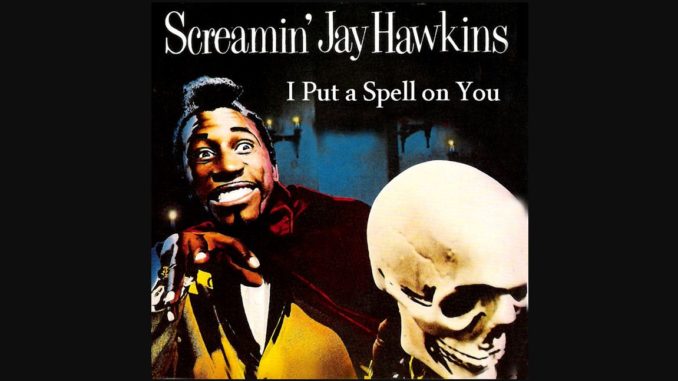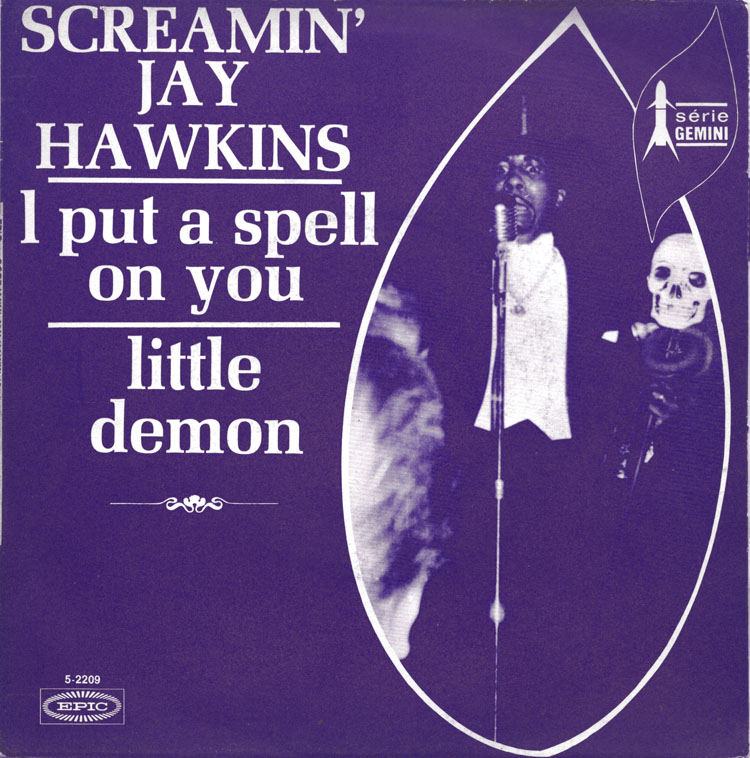
That primal scream, expressing a mixture of pain, sadness, deep longing, and scorned fury. The musical backdrop consisting of an eerie, spellbound musical voodoo rhythm. The raging, deranged madness that stems from the deep obsession, as strong as if voodoo magic joined two souls together, intertwined them and bound them together for eternity, only to rip them apart. The pain is real. When we hear the song that contains all of this, we can feel that pain, too.
I Put A Spell On You is as intense a song as you’ll ever hear. The instrumentation is very simple – almost naked, initially being recorded with just piano, bass, and drums alongside Hawkins’ unique vocal. It would later be expanded with horns and strings, which helps emphasise and give the song its haunting quality.
The song had humbler beginnings, though. It started out as something more straightforward and far less potent.
Hawkins first wrote and recorded I Put A Spell On You as a ballad lamenting the loss of a girlfriend he wanted back. It was a personal song, created after he experienced a particularly humiliating kiss-off by a fed-up girlfriend, who waved goodbye right as he was playing with his band.
“The next day I was sitting at the piano,” Hawkins told The Washington Post in 1990, “wondering why she left me. I didn’t want to admit I was wrong, and I was tapping on the piano and I said, ‘This is so stupid, to walk away and leave me like that without giving me a chance to explain… She didn’t know she’s was messing with a witch doctor… I’ll put a spell on her!’ “
The original version was slower and more of a classic blues love ballad. It was recorded in that style during Hawkins’ first stint with Grand Records in late 1955. For whatever reason, it was not seen as his best work, and he had a hard time convincing them to release this version of the song. They passed on it, but it has since been reissued by Rev-Ola/Cherry Red on the retrospective collection The Whamee 1953-55 in 2006.
The following year, Hawkins was recording for Okeh Records and pulled the song out again for another attempt. The producer Arnold Maxin still found it to be somewhat tame, but felt there was a potential. He felt something could be done with that song if it was tweaked a little. It needed a touch of anger, some fire, a dash of savage hurt… in other words, some intensity in the delivery.
Different arrangements were tried, and the song’s lyrics were altered. Instead of focusing on lamenting the loss of a girlfriend and/or pleading with her to come back, he is now putting a spell on her so he can have her.
The song was getting somewhere, but performances were still too restrained. The producer thought about this and made a plan. On the evening of 12 September 1956, he brought in ribs, chicken, and plenty of adult beverages to loosen things up and bring up the mood. It worked! Later that night the magic happened.
I put a spell on you
Because you’re mine
Stop the things you tell
Watch out, I ain’t lyin’
Yeah, I can’t stand it
No runnin’ around
I can’t stand it
No, put me down
I put a spell on you
Because you’re mine, oh yeah
“Maxim got everybody drunk, and we came out with this weird version… I don’t even remember making the record,” Hawkins later said in Julia Rubiner’s book Contemporary Musicians: Profiles of the People in Music: Volume 8. He continued, “Before, I was just a normal blues singer. I was just Jay Hawkins. It all sort of just fell in place. I found out I could do more destroying a song and screaming it to death.”
There is an unconfirmed myth which tells the story that Hawkins was startled when a messenger showed up with the single in hand ten days later. The drink had flown freely in the studio, and Hawkins could not remember how the song had ended up.
The song’s haunting quality and Hawkins’ unique vocal style made it an instant classic. Nobody had screamed quite like that on record before. It actually scared people, or made them upset, and that’s not even taking into account the grunts and moans from the end of the song. It all depicts a man in pain, but the song would be deeply misunderstood.

The song was released as a single in November 1956 with the suitably titled Little Demon as the b-side. It was promptly banned from most radio programming for its outrageous “cannibalistic sound.” You read that correctly – people genuinely thought (or at least claimed to think) that the sounds toward the end of the song sounds like a man eating somebody else. Additionally, Hawkins’ singing, screaming, and grunting also sounded overtly sexual to mainstream audiences. To round off the broad round of issues, the end sounds were also likened to animal noises. They just could not come up with enough examples of things that were found outrageous and offensive. The fact that Hawkins was black contributed to these and other racist takes on the song.
The song also genuinely scared a lot of people, particularly the white, god-fearing part of the population, who took the title literally. Without being particularly knowledgeable about the voodoo legends, they found the song’s voodoo overtones to be so genuine that they were concerned that an actual spell was being cast, or that a certain unholy magic was unleashed, whenever the song was played. In other words: they believed the record was capable of casting evil voodoo spells, which naturally came directly out of the tribal culture which undoubtedly existed somewhere in the deep wetlands of the Delta. Sometimes fiction is never as crazy as what some people think of as facts.
It would turn out to be near impossible to fight against the many stereotypes the song faced. A toned-down version of the song was produced and released in the hopes of getting around a lot of the complaints, but that would not get much radio play either, which probably illuminated the real problem.
While all of this may have prevented the song from getting any chart success, the song did find its audience and became a steady and continual slow-burn seller. The controversies around it may have been a selling point on its own, and the original single ended up selling over a million copies. It had the odd distinction at the time of being an incredibly popular and well-known song without being a hit song.
Not all radio DJs were against the song. Cleveland disc jockey Alan Freed was a fan, who promptly added the track to his Rock and Roll Revue and even struck up a friendship with Hawkins. It was Freed who would suggest the gimmick that would bring Hawkins even more fame and notoriety.
Up to this time, Hawkins had seen himself as a blues performer. He would get emotional but not really wild. As I Put A Spell On You had a crazier, almost demented sound, Freed suggested that he capitalize on it and build a persona to match. After some experimenting, Hawkins started wearing a long cape and would appear onstage by rising out of a coffin in the midst of smoke and fog. He would use a “screaming wardrobe” including zebra stripes, bright colors, and sometimes a loin cloth.
Hawkins performed the ghoulish version for the first time at a Christmas concert staged by Freed in 1956. He got a huge reaction from the song, and Freed invited him to perform it on his TV special. Hawkins developed a bizarre stage show around this. He would come out in a flaming coffin and wield a skull on a stick that he named Henry.
The act was a sensation, later bolstered by tusks worn in Hawkins’ nose, a turban on his head, on-stage snakes and fireworks. Henry, aka. the skull on a stick, would become a recurring fixture, known for sometimes smoking his cigarette while he sang. Ultimately, Hawkins transformed himself into “the black Vincent Price.”
This theatrical act was one of the first shock rock performances, making Hawkins the pioneer of a subgenre which was later popularized by artists like Alice Cooper, KISS, Ozzy Osbourne, and Marilyn Manson.
The NAACP denounced his act with concerns that he was propagating stereotypes of African Americans as cannibals or witch doctors. Some African American newspapers and magazines ignored Hawkins, not wanting to promote his music. The song was released in the era of Jim Crow segregation and the Civil Rights Movement. Many in the Black community had concerns about the act being consumed by white audiences for which it upheld dangerous and negative images of Black people.
Hawkins was hurt at the criticism. “What’s wrong with acting like a wild warrior?” Hawkins said at the time. “I’m making a living. I’m not breaking the law. How dare you?”
Despite all of this, I Put A Spell On You was Hawkins’ biggest hit, and it has never gone away. The song has become a Halloween classic, ensuring that it is remembered and carried forward every year.
The song has also gone on to be covered by numerous artists, including several versions who went on to get the chart success that eluded Hawkins. There are several hundred cover versions. Most of the covers treat the song seriously, not attempting to duplicate Hawkins’ bravura performance. That is probably for the best.
Nina Simone’s cover is particularly well known, to many being the version of the song they know best. Her version took on a whole new meaning as it was slowed it down to the ballad tempo the song originally had, but with powerhouse vocals and jazz style scatting. The track ended up becoming such a vital part of Simone’s body of work that she even titled her autobiography I Put A Spell On You.
The Creedence Clearwater Revival version is also well known (opening their debut album, and being their second single). Several people have also pointed out an amazing version of the track by Angelina Jordan, who (at only 9 years of age!) recorded a deeply soulful and harmonic version of the song in her own arrangement which is well worth seeking out. The most streamed version of the song in recent years is however Bette Midler’s version from the movie Hocus Pocus. The song has thus come full circle, starting with a radio ban as a scary, devilish cannibalistic piece of evil, and ending up as a fully embraced and wholesome Disney favourite.
Other notable versions are made by Bryan Ferry, Annie Lennox, The Crazy World of Arthur Brown, Jeff Beck (who was Grammy nominated for his version), Alan Price Set, Marilyn Manson, and Sonique, most of whom got some degree of chart success with it.
It was however Screamin’ Jay Hawkins own version that was selected as one of the Rock and Roll Hall of Fame’s 500 Songs that shaped Rock’n’Roll. It was also included in Robert Christgau’s Basic Record Library of 1950s and 1960s recordings, and ranked #313 on Rolling Stone Magazine’s The 500 Greatest Songs of All Time. That old black magic continues to weave its spell pretty well.
But what about the original version from 1955, which we for all these years had been told was very different, a limp version, and just not good enough? When it was eventually released in 2006, most people found it to actually be pretty good, and not as far removed from the treatment it would eventually get as the original comments led us to believe. There is no doubt, though, that it highly benefitted from the extra spit and polish.

Facebook Comments